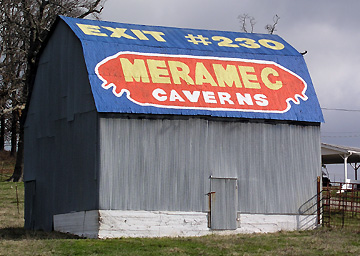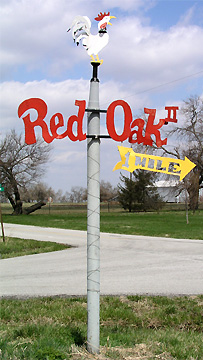
 |
Missouri, Sunday, March 23, 2008
 Typically
I awaken sometime between five and six (though much earlier on occasion), so
I was delighted to find that my morning clock is advancing a little. Getting
up at around seven, I thought I'd enjoy a quiet morning in my room, reading
or catching up on the news. But as it often happens on these trips I quickly
felt the pull to get back on the road. So after a quick photo of Wrink's
Market (now reopened!) and a tasty breakfast at the counter of Lebanon's
Bell Restaurant, I began to thread myself through windy roads headed southwest.
I snapped a quick picture of Abbylee
Modern Court, being a sucker for the "modern"
and "moderene" craze that swept through motel nomenclature during
the 30s and 40s, and slowed down in Springfield long enough to photograph the
Rest Haven Court and the Rancho
Court.
Typically
I awaken sometime between five and six (though much earlier on occasion), so
I was delighted to find that my morning clock is advancing a little. Getting
up at around seven, I thought I'd enjoy a quiet morning in my room, reading
or catching up on the news. But as it often happens on these trips I quickly
felt the pull to get back on the road. So after a quick photo of Wrink's
Market (now reopened!) and a tasty breakfast at the counter of Lebanon's
Bell Restaurant, I began to thread myself through windy roads headed southwest.
I snapped a quick picture of Abbylee
Modern Court, being a sucker for the "modern"
and "moderene" craze that swept through motel nomenclature during
the 30s and 40s, and slowed down in Springfield long enough to photograph the
Rest Haven Court and the Rancho
Court.
At this point I figured it wouldn't be practical to aim for a long-sought destination,
a night in Tulsa's Desert Hills Motel (featuring a neon sign I'd always wanted
to photograph at twilight), since I was likely to stop by a few spots between
here and there relatively quickly. How wrong I was. Cruising a quiet stretch
of road marked with ghost buildings,
I spotted a brightly painted Sinclair gas station in Paris Springs and and read
the sign: Gay Parita. The gate was
open, though no one was around, so I walked around a little. Before long a fellow
stepped out of a nearby house and advanced toward me; I felt that familiar twinge.
Was I trespassing? Nodding appreciatively at the station, I said, "It looks
like a labor of love!" He broke open into a broad smile and asked if I'd
like a tour. Before I knew it, I'd just met Gary Turner, a guy who rebuilt a
gas station that burned down in 1955 just so he could greet travelers passing
through. Gary showed me lots of pics of how the place had changed, beaming with
pride at his glorious reproduction, but more than anything, he was thrilled
at how many people have visited him since he rebuilt Gay Parita. Visitors have
mailed him souvenirs from all over the world, all expressing their joy at chatting
with this guy. I suppose the way best to describe Gary is to point at the poster
of Cars over his desk. Remember Tow Mater? Imagine that beloved character
in human form: that's Gary.
After asking my profession, Gary
expressed that he had nothing more than a ninth grade education, though he'd
made a million in the car business in California. He told me that he'd have
been "dangerous" if he'd continued his schooling. I gently replied
that education is hardly the only mark of intelligence, but he was having none
of it. Showing me every square inch of his station, Gary added pictures, postcards,
and other knickknacks to a pile of stuff he wanted me to take on my journey.
I saw a button and said, "Oh, I've got to get this. How much?" But
he didn't want a dime. Before long I knew I had to ask for his photo. I'm always
a little awkward at this part. I read too much into it, I suppose, but taking
a person's picture in a touristic context is laden with symbolic meaning to
me. It just doesn't seem like a fair exchange. But Gary has done this before.
He grabbed a cap and put a phone to his ear, just like a gas station attendant
in 1955 (for all I know).
 Gary
is one of those amazing people who understand our need for simulacra of Route
66. He didn't just refurbish an old place on the road, he built a new one on
the ruins of the old, a better one than could have existed back then. Like a
showman, he's got snappy patter, well-worn jokes, and ready props to assist
in the creation of a Mother Road experience. Yet, and this is the part that
amazes me, he doesn't seem to trade in currency. He only wants folks to send
him postcards or books or videos or other mementos of their visits when they
return home. Writing this, I commit to sending Gary a copy of that Road
Trip America book I wrote a few years back, regretting that I didn't feature
him. If I ever write a sequel, I'll do the job right.
Gary
is one of those amazing people who understand our need for simulacra of Route
66. He didn't just refurbish an old place on the road, he built a new one on
the ruins of the old, a better one than could have existed back then. Like a
showman, he's got snappy patter, well-worn jokes, and ready props to assist
in the creation of a Mother Road experience. Yet, and this is the part that
amazes me, he doesn't seem to trade in currency. He only wants folks to send
him postcards or books or videos or other mementos of their visits when they
return home. Writing this, I commit to sending Gary a copy of that Road
Trip America book I wrote a few years back, regretting that I didn't feature
him. If I ever write a sequel, I'll do the job right.
As I'm planning to depart, Gary insists that I take a minor detour into the
fields off the road. He says, "You'll burn your camera out on this place."
He gives me a small map and marks off the turns to Red Oak II and promises me
that it will be a highlight of my trip. He says something about a welder who's
made some cool gadgets, and
I'm not too interested. But I agree to go in honor of our visit. Again, how
wrong I was. Gary steered me straight into one of the coolest displays I've
ever seen on the road. Red Oak II is a town, a whole town, gathered from a nearby
part of the state and moved to a cornfield -- all the vision of Lowell Davis
who was saddened by the decline of his hometown into a ghost of its former self.
He's spent years refurbishing, painting, and organizing the place of his memory:
a gas station, a church, some homes,
a general store, a diner, some tourist
cabins, and lots of other sites.
I was the only person wandering the streets of Red Oak II when I visited, but
I wasn't alone. Dogs barked and kids played the coolest version of Cowboys and
Indians you could imagine, hiding around an actual marshal's
office located next to a graveyard. Wandering the streets were chickens
and geese, and a peacock strutting
with outstretched plumage. Interspersed among the buildings were placed some
of Lowell's clever and whimsical art
pieces. I chatted with him for a few minutes, petting a stray dog that he'd
named Fido, so as to avoid getting attached (six years later, Fido is fat and
happy on the front porch). Since it was Easter, I didn't want to take much of
Lowell's time, but he was happy to lend me the keys to the church, and I enjoyed
a moment of spirit and calm that did me good on this trip. Throughout my visit,
I seemed to continually shake my head in disbelief. Like the Field of Dreams,
Red Oak II is so cool that it seems unreal: a cornfield mirage. Leaving at last,
I stopped at a crossroads, gratified to see a metal sign for the place. It is
real. And if you're within two hundred miles of the place, you'd better get
gassed up for a drive.
A quick stop in Carthage to photograph Boots
Motel and I was heading for Kansas. [Continue...]
 |
 |
 |
 |
 |
 |
 |
|
All
text and photos copyright Andrew Wood |
|||